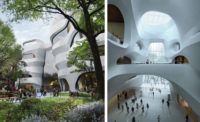Jeanne Gang Embraces ‘Actionable Idealism’ at Greenbuild 2019

Jeanne Gang spoke at Greenbuild 2019 in Atlanta on Thursday, November 21, 2019.
Photo © Architectural Record

Jeanne Gang described the framework that her firm uses to consider all the scales at which green strategies can be deployed, from “self” to “earth.”
Photo © Architectural Record


Architects & Firms
“Actionable idealism,” said Jeanne Gang on the morning of Thursday, November 20. “We want to create a world where big ideas can be articulated, but at the same time, they can be done in our lifetime." The Chicago-based architect used this concept as the thesis for her keynote speech at Greenbuild, the U.S. Green Building Council’s (USGBC) annual conference, held this year in Atlanta.
Gang shared the framework that her firm uses to consider all the scales at which green strategies can be deployed, from “self” to “earth.”
At an individual level, architects and designers can grow their expertise, said Gang. “Taking it upon ourselves to be knowledgeable, get accredited. That’s something that everyone can do.”
Considering the “family” scale—meaning homes and offices—Studio Gang's founder gave the case study of her firm’s own office: a renovated 1934 building with a green roof, planted with native flora, that serves as both an employee amenity and laboratory for research. During regular “bio blitz” days at the office, Gang explained, team members collect insects, test soil microbes, count plant species, and record bird sightings, all in an effort to build a data set that shows the impact the landscaped roof has on its surroundings.
Zooming out further to friends and neighbors, Gang continued with the example of the green roof, describing how the firm shares information with those in nearby buildings, working toward a larger goal of creating a “wildlife corridor in the sky.”
At the community scale, which she defines as the buildings and projects the firm designs, the aim is to connect people with each other and their environments, be that through a spec office building project like Solar Carve on the High Line in New York, where the end users are unknown, or an intimate, carefully crafted structure like ARCUS Center for Social Justice Leadership in Kalamazoo, Michigan.
Thinking about projects that touch humanity at large, Gang described the firm’s work on the Memphis riverfront, which they shared in the 2018 Venice Architecture Biennale and 2019 Chicago Architecture Biennial. As the firm began to reimagine the area, which had both historic and contemporary ties to slavery and race-based oppression, Gang asked, “How can communities remake their public spaces with complex histories?” In Memphis, the answer was through conducting interviews with members of the community. Studio Gang then created visual representations of the personal stories they heard, carving, milling, and laminating existing bricks with new layers of meaning.
Finally, at the global scale, Gang asked, “How do we impact other creatures?” Her firm has answered that in ways big and small, from using bird-safe glass in their buildings, to designing “Baleinopolis: The Secret Societies of Cetaceans”—an installation for Aquarium du Palais de la Porte Dorée in Paris.
By starting with the scale “that’s most comfortable and interesting to you,” Gang said, “we can set up relationships between people, between us and other people, and connect us closely to our environment.”





